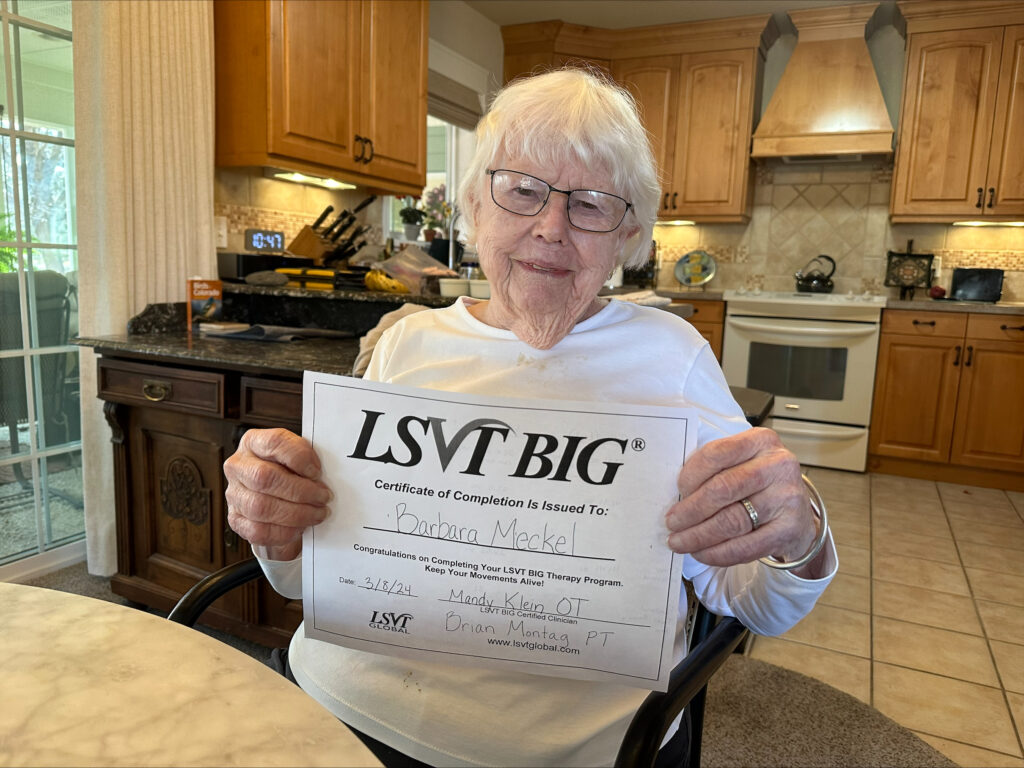Improve your quality of life with LSVT BIG®Therapy!
LSVT BIG®: Therapy for Parkinson’s Disease and Other neurological conditions
Introducing “LSVT BIG” an individualized therapy in-home treatment to help people with Parkinson’s Disease and other neurological conditions live a meaningful, confident, and empowered life.
What is LVST BIG?
LSVT BIG trains people with Parkinson’s disease (PD) to use their body more normally. People living with PD or other neurological conditions often move differently, with gestures and actions that become smaller and slower. They may have trouble with getting around, getting dressed and with other activities of daily living. LSVT BIG effectively trains improved movements for any activity, whether “small motor” tasks like buttoning a shirt or “large motor” tasks like getting up from sofa or chair or maintaining balance while walking. The treatment improves walking, self-care and other tasks by helping people “recalibrate” how they perceive their movements with what others see. It also teaches them how and when to apply extra effort to produce bigger motions – more like the movements of everyone around them.
Each treatment is customized to each person’s specific needs and goals. SVT BIG treatment is delivered one-on-one and is tailored to each person’s own abilities and goals so that they work towards what’s meaningful to them. It requires (and can only be given by) an LSVT BIG Certified Clinician as part of prescribed physical or occupational therapy.
LSVT BIG is a 4 week program
Who can LVST BIG Help?
Regardless of the stage or severity of your condition, LSVT BIG can produce significant improvements even for people facing considerable physical difficulties. It is never too late to start.
As part of their certification process, clinicians who use LSVT BIG learn when the treatment might be helpful for other conditions. While research on LSVT BIG has focused on people with PD, LSVT Certified Clinicians can adapt its exercises and functional tasks to help overcome challenges arising from a variety of conditions.
While outcomes may vary, clinicians overall report that LSVT BIG can provide benefit to these patients in terms of:
- Higher-quality and safer movement
- Reduced secondary complications, including falls
- Better maintained range of motion and strength
- Improved quality of life overall
After LSVT BIG Treatment
The standard LSVT BIG treatment spans a minimum of one month, including daily practice and carryover exercises. Once that initial treatment is over, you’ll continue to practice at least once a day for 10–15 minutes, which readies you to use your new movement skills all day at home.
Tune-up Sessions – When you finish the four week LSVT BIG program, you and your therapist will decide when to return for a reassessment. Periodic “tune-up” sessions are recommended to provide you with motivation and feedback to help you maintain the benefits of your hard work.
For more information, visit LSVT GLOBAL
Enrollment & Referrals
The LSVT BIG Program is a referral based program initiated by your primary care provider.
Referrals can be faxed to 970-243-6855. Each referral must reference the LSVT BIG Program.
For more information on starting services, please call 970-263-0202
Insurances accepted: Medicare, Medicaid, Private Insurance, some Advantage Plans and Private Pay
